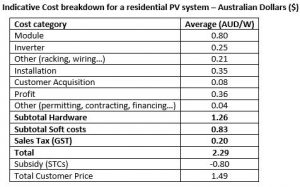With high solar prices impeding the initial uptake of the technology when it first hit the residential market and feed-in tariffs being rolled back in recent years, many people assume a solar outlay is well beyond their means. Yet with cost decreases of up to 600 per cent off the original price structure, feed-in tariffs still available and the rise of battery storage, solar is now a more affordable investment than ever.
The Australian PV Institute’s ‘PV in Australia Report 2015’, which includes PV installations installed and connected between January 1 and December 31, 2015, shows that the price per watt declined around $10 per watt in the decade to 2015. Inlec West now offer systems priced from just $1 per watt, making a solar investment even more attractive.
In 2005, the unsubsidised price per watt sat at $12 and just above $2 per watt in 2015 (see Price Evolution graph).

Further detailed information breaks down the cost of a residential PV system of less than 10kW to cost $2.29 per watt before subsidies (see Indicative cost breakdown table). This means a 2kW system in 2005 would have cost $24,000. The same size system in 2015 would be priced at $4580, which is less than a fifth of the cost customers would have paid a decade earlier, with current STCs bringing that cost down even further. Inlec West has 3kW systems, which are more economical as you pay less per watt for installation, starting from $3300.

Although feed-in tariffs aren’t as high as they have been in previous years, currently sitting at 0.07135c per kW, Inlec West director Quinten Lilleyman said solar was still an attractive investment.
“Electricity prices have increased dramatically in recent years, and I’d expect they will keep going up, so it makes sense to harness the effectiveness of solar power to save money,” Mr Lilleyman said.
“Many systems now come with a five year buy-back period, or better, so it means you will be effectively making a 20 per cent return on your investment over five years.
“Then after the buy-back period ends, five years for example, once the system is paid off with the savings, every year after that for the life of the system you will be saving on your electricity bill, which is money back in your pocket.
“Add to that, the value of your house will also increase, with thrifty buyers now looking for more economical homes, and there’s also the knowledge that you’re reducing the amount of greenhouse gases produced by your home and doing your bit for the environment.”
“With Australia having the highest solar radiation per square metre of any continent in the world, we are in the best position to make the most of our solar opportunities.
“So with solar addressing environmental, equity and monetary principles – can you afford not to have solar?”

